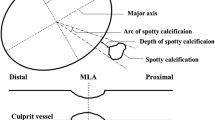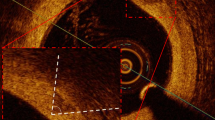Abstract
Background
The minimal fibrous cap thickness overlying the necrotic lipid core as well as the presence of macrophages are established characteristics of coronary plaque vulnerability. Recently, the presence of microcalcifications has emerged as a novel feature of vulnerable lesions. However, clinical and plaque morphological predictors of microcalcifications are unknown.
Methods
In patients with stable coronary artery disease, analysis of plaque morphology (n = 112) was performed using optical coherence tomography prior to coronary intervention to assess predictors of microcalcifications.
Results
Microcalcifications were present in 21/112 (18.7%) lesions. Segments with microcalcifications showed a higher total number of calcifications per lesion (6.7 ± 3.0 vs. 3.2 ± 2.5, p < 0.001), a lower percent area stenosis (70.9 ± 11.1 vs. 76.2 ± 9.7%, p = 0.028), and a higher frequency of macrophage infiltration (66.7 vs. 37.4%, p = 0.014). In lesions with vs. without microcalcifications, macrophage infiltration was characterized by a wider macrophage angle (31.1° ± 34.4° vs. 13.7° ± 20.6°, p = 0.003), a higher macrophage index (105.6 ± 269.0 vs. 31.6 ± 66.5° mm, p = 0.020), and an increased frequency of calcium–macrophage co-localization (47.6 vs. 15.6%, p = 0.001). In multivariable logistic regression analysis, the total number of calcifications per lesion (OR 1.53, 95% CI 1.23–1.91, p < 0.001), average macrophage angle (OR 1.28 for 10°-variation, 95% CI 1.03–1.60, p = 0.024), and percent area stenosis (OR 0.59 for 10% increase, 95% CI 0.34–1.04, p = 0.070) were independent predictors for the presence of microcalcifications, whereas the latter did not reach statistical significance.
Conclusion
Microcalcifications are related to a less advanced stenosis severity and to extensive plaque inflammation, but not to clinical parameters. Our data may add to the understanding and role of microcalcifications in coronary artery lesions.


Similar content being viewed by others
Abbreviations
- 18F-NaF 18:
-
Sodium fluoride
- ACS:
-
Acute coronary syndrome
- CAD:
-
Coronary artery disease
- CT:
-
Computed tomography
- FCT:
-
Fibrous cap thickness
- FFR:
-
Fractional flow reserve
- IVUS:
-
Intravascular ultrasound
- OCT:
-
Optical coherence tomography
References
Yamamoto H, Imazu M, Hattori Y, Tadehara F, Yamakido M, Nakanishi T et al (1998) Predicting angiographic narrowing> or = 50% in diameter in each of the three major arteries by amounts of calcium detected by electron beam computed tomographic scanning in patients with chest pain. Am J Cardiol 81(6):778–780
Frink RJ, Achor RW, Brown AL, Kincaid OW, Brandenburg RO (1970) Significance of calcification of the coronary arteries. Am J Cardiol 26(3):241–247
Tanenbaum SR, Kondos GT, Veselik KE, Prendergast MR, Brundage BH, Chomka EV (1989) Detection of calcific deposits in coronary arteries by ultrafast computed tomography and correlation with angiography. Am J Cardiol 63(12):870–872
Arad Y, Spadaro LA, Goodman K, Newstein D, Guerci AD (2000) Prediction of coronary events with electron beam computed tomography. J Am Coll Cardiol 36(4):1253–1260
Vengrenyuk Y, Carlier S, Xanthos S, Cardoso L, Ganatos P, Virmani R et al (2006) A hypothesis for vulnerable plaque rupture due to stress-induced debonding around cellular microcalcifications in thin fibrous caps. Proc Natl Acad Sci USA 103(40):14678–14683. https://doi.org/10.1073/pnas.0606310103
Sinclair H, Bourantas C, Bagnall A, Mintz GS, Kunadian V (2015) OCT for the identification of vulnerable plaque in acute coronary syndrome. JACC Cardiovasc Imaging 8(2):198–209. https://doi.org/10.1016/j.jcmg.2014.12.005
Burgmaier M, Hellmich M, Marx N, Reith S (2014) A score to quantify coronary plaque vulnerability in high-risk patients with type 2 diabetes: an optical coherence tomography study. Cardiovasc Diabetol 13:117. https://doi.org/10.1186/s12933-014-0117-8
Ehara S, Kobayashi Y, Yoshiyama M, Shimada K, Shimada Y, Fukuda D et al (2004) Spotty calcification typifies the culprit plaque in patients with acute myocardial infarction: an intravascular ultrasound study. Circulation 110(22):3424–3429. https://doi.org/10.1161/01.CIR.0000148131.41425.E9
Mizukoshi M, Kubo T, Takarada S, Kitabata H, Ino Y, Tanimoto T et al (2013) Coronary superficial and spotty calcium deposits in culprit coronary lesions of acute coronary syndrome as determined by optical coherence tomography. Am J Cardiol 112(1):34–40. https://doi.org/10.1016/j.amjcard.2013.02.048
Sakaguchi M, Hasegawa T, Ehara S, Matsumoto K, Mizutani K, Iguchi T et al (2016) New insights into spotty calcification and plaque rupture in acute coronary syndrome: an optical coherence tomography study. Heart Vessels 31(12):1915–1922. https://doi.org/10.1007/s00380-016-0820-3
Ong DS, Lee JS, Soeda T, Higuma T, Minami Y, Wang Z et al. (2016). Coronary calcification and plaque vulnerability: an optical coherence tomographic study. Circ Cardiovasc Imaging. https://doi.org/10.1161/CIRCIMAGING.115.003929
Kataoka Y, Puri R, Hammadah M, Duggal B, Uno K, Kapadia SR et al (2014) Spotty calcification and plaque vulnerability in vivo: frequency-domain optical coherence tomography analysis. Cardiovasc Diagn Ther 4(6):460–469. https://doi.org/10.3978/j.issn.2223-3652.2014.11.06
Kelly-Arnold A, Maldonado N, Laudier D, Aikawa E, Cardoso L, Weinbaum S (2013) Revised microcalcification hypothesis for fibrous cap rupture in human coronary arteries. Proc Natl Acad Sci USA 110(26):10741–10746. https://doi.org/10.1073/pnas.1308814110
Cardoso L, Kelly-Arnold A, Maldonado N, Laudier D, Weinbaum S (2014) Effect of tissue properties, shape and orientation of microcalcifications on vulnerable cap stability using different hyperelastic constitutive models. J Biomech 47(4):870–877. https://doi.org/10.1016/j.jbiomech.2014.01.010
Maldonado N, Kelly-Arnold A, Vengrenyuk Y, Laudier D, Fallon JT, Virmani R et al (2012) A mechanistic analysis of the role of microcalcifications in atherosclerotic plaque stability: potential implications for plaque rupture. Am J Physiol Heart Circ Physiol 303(5):H619–H628. https://doi.org/10.1152/ajpheart.00036.2012
Blachutzik F, Boeder N, Wiebe J, Mattesini A, Dörr O, Most A et al (2017) Post-dilatation after implantation of bioresorbable everolimus- and novolimus-eluting scaffolds: an observational optical coherence tomography study of acute mechanical effects. Clin Res Cardiol 106(4):271–279. https://doi.org/10.1007/s00392-016-1048-z
Nijhoff F, Stella PR, Troost MS, Belkacemi A, Nathoe HM, Voskuil M et al (2016) Comparative assessment of the antirestenotic efficacy of two paclitaxel drug-eluting balloons with different coatings in the treatment of in-stent restenosis. Clin Res Cardiol 105(5):401–411. https://doi.org/10.1007/s00392-015-0934-0
Poerner TC, Duderstadt C, Goebel B, Kretzschmar D, Figulla HR, Otto S (2017) Fractional flow reserve-guided coronary angioplasty using paclitaxel-coated balloons without stent implantation: feasibility, safety and 6-month results by angiography and optical coherence tomography. Clin Res Cardiol 106(1):18–27. https://doi.org/10.1007/s00392-016-1019-4
Florian A, Fischer D, Yilmaz A (2016) The “spastic” coronary plaque: dynamic deformation of an atheromatous plaque demonstrated by optical coherence tomography. Clin Res Cardiol 105(7):636–638. https://doi.org/10.1007/s00392-016-0976-y
Reith S, Battermann S, Hellmich M, Marx N, Burgmaier M (2015) Correlation between optical coherence tomography-derived intraluminal parameters and fractional flow reserve measurements in intermediate grade coronary lesions: a comparison between diabetic and non-diabetic patients. Clin Res Cardiol 104(1):59–70. https://doi.org/10.1007/s00392-014-0759-2
Kume T, Okura H, Kawamoto T, Yamada R, Miyamoto Y, Hayashida A et al (2011) Assessment of the coronary calcification by optical coherence tomography. Eurointervention 6(6):768–772. https://doi.org/10.4244/EIJV6I6A130
Krishnamoorthy P, Vengrenyuk Y, Ueda H, Yoshimura T, Pena J, Motoyama S et al (2017) Three-dimensional volumetric assessment of coronary artery calcification in patients with stable coronary artery disease by OCT. Eurointervention 13(3):312–319. https://doi.org/10.4244/EIJ-D-16-00139
Wang X, Matsumura M, Mintz GS, Lee T, Zhang W, Cao Y et al (2017) In vivo calcium detection by comparing optical coherence tomography, intravascular ultrasound, and angiography. JACC Cardiovasc Imaging 10(8):869–879. https://doi.org/10.1016/j.jcmg.2017.05.014
van der Giessen AG, Gijsen FJ, Wentzel JJ, Jairam PM, van Walsum T, Neefjes LA et al (2011) Small coronary calcifications are not detectable by 64-slice contrast enhanced computed tomography. Int J Cardiovasc Imaging 27(1):143–152. https://doi.org/10.1007/s10554-010-9662-8
Milzi A, Burgmaier M, Burgmaier K, Hellmich M, Marx N, Reith S (2017) Type 2 diabetes mellitus is associated with a lower fibrous cap thickness but has no impact on calcification morphology—an intracoronary optical coherence tomography study. Cardiovasc Diabetol 16:152. https://doi.org/10.1186/s12933-017-0635-2
Reith S, Battermann S, Hellmich M, Marx N, Burgmaier M (2014) Impact of type 2 diabetes mellitus and glucose control on fractional flow reserve measurements in intermediate grade coronary lesions. Clin Res Cardiol 103(3):191–201. https://doi.org/10.1007/s00392-013-0633-7
Tearney GJ, Regar E, Akasaka T, Adriaenssens T, Barlis P, Bezerra HG et al (2012) Consensus standards for acquisition, measurement, and reporting of intravascular optical coherence tomography studies: a report from the international working group for intravascular optical coherence tomography standardization and validation. J Am Coll Cardiol 59(12):1058–1072. https://doi.org/10.1016/j.jacc.2011.09.079
Criqui MH, Denenberg JO, Ix JH, McClelland RL, Wassel CL, Rifkin DE et al (2014) Calcium density of coronary artery plaque and risk of incident cardiovascular events. JAMA 311(3):271–278. https://doi.org/10.1001/jama.2013.282535
Criqui MH, Knox JB, Denenberg JO, Forbang NI, McClelland RL, Novotny TE et al (2017) Coronary artery calcium volume and density: potential interactions and overall predictive value: the multi-ethnic study of atherosclerosis. JACC Cardiovasc Imaging 10(8):845–854. https://doi.org/10.1016/j.jcmg.2017.04.018
Maldonado N, Kelly-Arnold A, Cardoso L, Weinbaum S (2013) The explosive growth of small voids in vulnerable cap rupture; cavitation and interfacial debonding. J Biomech 46(2):396–401. https://doi.org/10.1016/j.jbiomech.2012.10.040
Hsu JJ, Lim J, Tintut Y, Demer LL (2016) Cell-matrix mechanics and pattern formation in inflammatory cardiovascular calcification. Heart 102(21):1710–1715. https://doi.org/10.1136/heartjnl-2016-309667
New SE, Aikawa E (2011) Cardiovascular calcification: an inflammatory disease. Circ J 75(6):1305–1313
Nadra I, Mason JC, Philippidis P, Florey O, Smythe CDW, McCarthy GM et al (2005) Proinflammatory activation of macrophages by basic calcium phosphate crystals via protein kinase C and map kinase pathways. Circ Res 96:1248–1256. https://doi.org/10.1161/01.RES.0000171451.88616.c2
New SE, Goettsch C, Aikawa M, Marchini JF, Shibasaki M, Yabusaki K et al (2013) Macrophage-derived matrix vesicles: an alternative novel mechanism for microcalcification in atherosclerotic plaques. Circ Res 113(1):72–77. https://doi.org/10.1161/CIRCRESAHA.113.301036
New SE, Aikawa E (2013) Role of extracellular vesicles in de novo mineralization: an additional novel mechanism of cardiovascular calcification. Arterioscler Thromb Vasc Biol 33(8):1753–1758. https://doi.org/10.1161/ATVBAHA.112.300128
Ikeda K, Souma Y, Akakabe Y, Kitamura Y, Matsuo K, Shimoda Y et al (2012) Macrophages play a unique role in the plaque calcification by enhancing the osteogenic signals exerted by vascular smooth muscle cells. Biochem Biophys Res Commun 425(1):39–44. https://doi.org/10.1016/j.bbrc.2012.07.045
Liu H, Yuan L, Xu S, Wang K (2007) Endothelial cell and macrophage regulation of vascular smooth muscle cell calcification modulated by cholestane-3beta, 5alpha, 6beta-triol. Cell Biol Int 31(9):900–907. https://doi.org/10.1016/j.cellbi.2007.02.009
Shioi A, Katagi M, Okuno Y, Mori K, Jono S, Koyama H et al (2002) Induction of bone-type alkaline phosphatase in human vascular smooth muscle cells: roles of tumor necrosis factor-alpha and oncostatin M derived from macrophages. Circ Res 91(1):9–16
Derlin T, Richter U, Bannas P, Begemann P, Buchert R, Mester J et al (2010) Feasibility of 18F-sodium fluoride PET/CT for imaging of atherosclerotic plaque. J Nucl Med 51(6):862–865. https://doi.org/10.2967/jnumed.110.076471
Derlin T, Tóth Z, Papp L, Wisotzki C, Apostolova I, Habermann CR et al (2011) Correlation of inflammation assessed by 18F-FDG PET, active mineral deposition assessed by 18F-fluoride PET, and vascular calcification in atherosclerotic plaque: a dual-tracer PET/CT study. J Nucl Med 52(7):1020–1027. https://doi.org/10.2967/jnumed.111.087452
Dweck MR, Chow MW, Joshi NV, Williams MC, Jones C, Fletcher AM et al (2012) Coronary arterial 18F-sodium fluoride uptake: a novel marker of plaque biology. J Am Coll Cardiol 59(17):1539–1548. https://doi.org/10.1016/j.jacc.2011.12.037
Joshi NV, Vesey AT, Williams MC, Shah AS, Calvert PA, Craighead FH et al (2014) 18F-fluoride positron emission tomography for identification of ruptured and high-risk coronary atherosclerotic plaques: a prospective clinical trial. Lancet 383(9918):705–713. https://doi.org/10.1016/S0140-6736(13)61754-7
Chatrou ML, Cleutjens JP, van der Vusse GJ, Roijers RB, Mutsaers PH, Schurgers LJ (2015) Intra-section analysis of human coronary arteries reveals a potential role for micro-calcifications in macrophage recruitment in the early stage of atherosclerosis. PLoS One 10(11):e0142335. https://doi.org/10.1371/journal.pone.0142335
Abedin M, Tintut Y, Demer LL (2004) Vascular calcification: mechanisms and clinical ramifications. Arterioscler Thromb Vasc Biol 24(7):1161–1170
Author information
Authors and Affiliations
Corresponding author
Ethics declarations
Conflict of interest
The authors declare that they have no conflict of interest.
Rights and permissions
About this article
Cite this article
Reith, S., Milzi, A., Dettori, R. et al. Predictors for target lesion microcalcifications in patients with stable coronary artery disease: an optical coherence tomography study. Clin Res Cardiol 107, 763–771 (2018). https://doi.org/10.1007/s00392-018-1243-1
Received:
Accepted:
Published:
Issue Date:
DOI: https://doi.org/10.1007/s00392-018-1243-1




